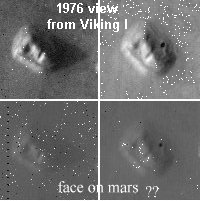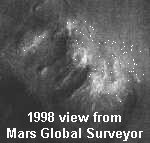

Under ordinary circumstances, pareidolia provides a psychological explanation for many delusions based upon sense perception. For example, it explains many UFO sightings and hearing sinister messages on records played backwards. Pareidolia explains Elvis, Bigfoot, and Loch Ness Monster sightings. It explains numerous religious apparitions and visions. And it explains why some people see a face or a building in a photograph of the Cydonia region of Mars.
Under clinical circumstances, however, some psychologists encourage pareidolia as a means to understanding a patient. Perhaps, the most infamous example of this type of clinical procedure is the Rorschach ink blot test.
Astronomer Carl Sagan believes that the human tendency to see faces
in tortillas, clouds, cinnamon buns, etc. is an evolutionary trait. He
writes:
As soon as the infant can see, it recognizes faces, and we now know that this skill is hardwired in our brains. Those infants who a million years ago were unable to recognize a face smiled back less, were less likely to win the hearts of their parents, and less likely to prosper. These days, nearly every infant is quick to identify a human face, and to respond with a goony [sic] grin. [Sagan, p. 45]Maybe. Maybe not. In any case, Sagan's explanation of the face on Mars is less controversial than his explanation for our fascination with faces. In 1976, the Viking orbiter sent back some images of Mars which looked like a face but which NASA said was just a play of light and shadow. Some took this explanation as a sure sign of a cover-up. Some engineers and computer specialists digitally enhanced the NASA images. This soon gave birth to the claim that the face was a sculpture of a human being located next to a city whose temples and fortifications could also be seen. Some began to wonder: were these built by the same beings who built the ancient airports in Peru and who were now communicating to us through elaborate symbols carved in wheat crop circles? Others took the wonder to the level of belief, based on the flimsiest of evidence and the grandest of imagination. Sagan's more down-to-earth explanation for the face on mars is that it is the result of erosion and winds and other natural forces. [Sagan, pp. 52-55]
Maybe the face on Mars was done by the artist who did the Shroud
of Turin. Some who have looked closely have seen a family resemblance.
See related entries on ancient astronauts,
Sitchin, and Velikovsky.